27句口诀 帮你记住初中英语所有不规则动词
- 格式:docx
- 大小:17.89 KB
- 文档页数:15
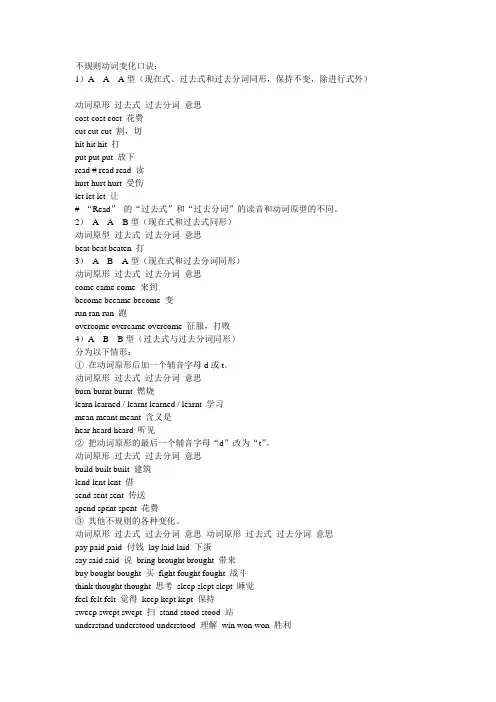
不规则动词变化口诀:1)A---A---A型(现在式、过去式和过去分词同形,保持不变,除进行式外)动词原形过去式过去分词意思cost cost cost 花费cut cut cut 割,切hit hit hit 打put put put 放下read # read read 读hurt hurt hurt 受伤let let let 让# “Read”的“过去式”和“过去分词”的读音和动词原型的不同。
2)A---A---B型(现在式和过去式同形)动词原型过去式过去分词意思beat beat beaten 打3)A---B---A型(现在式和过去分词同形)动词原形过去式过去分词意思come came come 来到become became become 变run ran run 跑overcome overcame overcome 征服,打败4)A---B---B型(过去式与过去分词同形)分为以下情形:①在动词原形后加一个辅音字母d或t。
动词原形过去式过去分词意思burn burnt burnt 燃烧learn learned / learnt learned / learnt 学习mean meant meant 含义是hear heard heard 听见②把动词原形的最后一个辅音字母“d”改为“t”。
动词原形过去式过去分词意思build built built 建筑lend lent lent 借send sent sent 传送spend spent spent 花费③其他不规则的各种变化。
动词原形过去式过去分词意思动词原形过去式过去分词意思pay paid paid 付钱lay laid laid 下蛋say said said 说bring brought brought 带来buy bought bought 买fight fought fought 战斗think thought thought 思考sleep slept slept 睡觉feel felt felt 觉得keep kept kept 保持sweep swept swept 扫stand stood stood 站understand understood understood 理解win won won 胜利catch caught caught 抓住teach taught taught 教find found found 发现get got got 得到hold held held 握leave left left 离开make made made 制造meet met met 遇见shoot shot shot 射击dig dug dug 挖smell smelt / smelled smelt / smelled 嗅,闻shine shone / shined shone / shined 发光sit sat sat 坐下have had had 有5)A---B---C型(三词不同形)分为以下情形:①在动词原形后加-n或-en 构成过去分词。
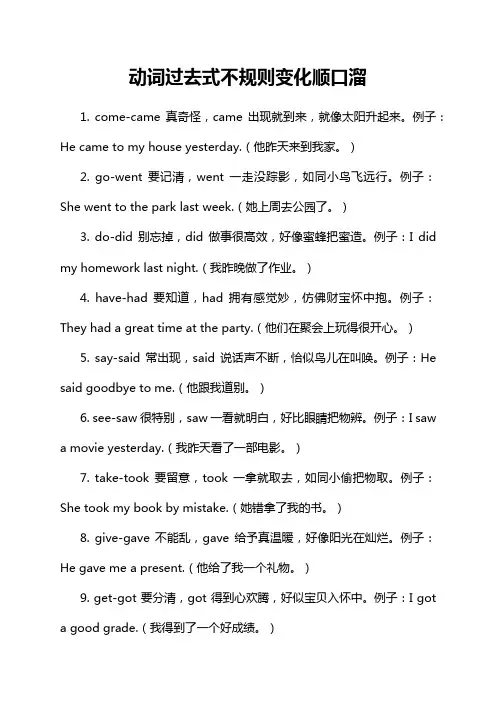
动词过去式不规则变化顺口溜1. come-came 真奇怪,came 出现就到来,就像太阳升起来。
例子:He came to my house yesterday.(他昨天来到我家。
)2. go-went 要记清,went 一走没踪影,如同小鸟飞远行。
例子:She went to the park last week.(她上周去公园了。
)3. do-did 别忘掉,did 做事很高效,好像蜜蜂把蜜造。
例子:I did my homework last night.(我昨晚做了作业。
)4. have-had 要知道,had 拥有感觉妙,仿佛财宝怀中抱。
例子:They had a great time at the party.(他们在聚会上玩得很开心。
)5. say-said 常出现,said 说话声不断,恰似鸟儿在叫唤。
例子:He said goodbye to me.(他跟我道别。
)6. see-saw 很特别,saw 一看就明白,好比眼睛把物辨。
例子:I sawa movie yesterday.(我昨天看了一部电影。
)7. take-took 要留意,took 一拿就取去,如同小偷把物取。
例子:She took my book by mistake.(她错拿了我的书。
)8. give-gave 不能乱,gave 给予真温暖,好像阳光在灿烂。
例子:He gave me a present.(他给了我一个礼物。
)9. get-got 要分清,got 得到心欢腾,好似宝贝入怀中。
例子:I gota good grade.(我得到了一个好成绩。
)10. fly-flew 飞呀飞,flew 飞翔天空美,就像风筝自由追。
例子:The bird flew away.(那只鸟飞走了。
)我的观点结论:这些顺口溜是不是很有趣呀!能帮助大家轻松记住动词过去式不规则变化呢!。
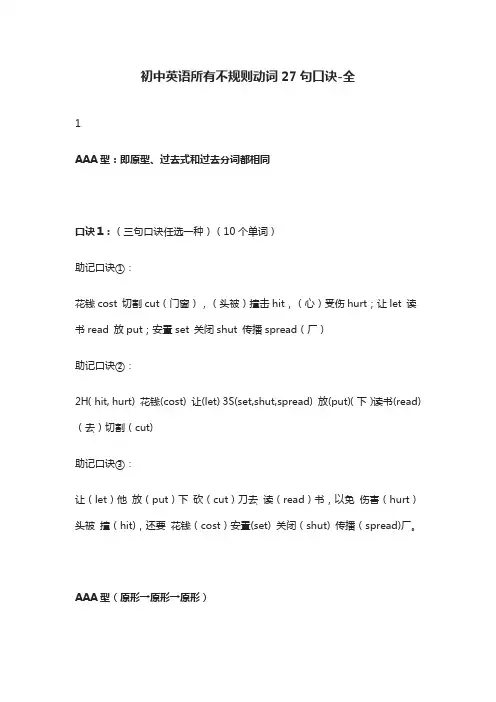
初中英语所有不规则动词27句口诀-全1AAA型:即原型、过去式和过去分词都相同口诀1:(三句口诀任选一种)(10个单词)助记口诀①:花钱cost 切割cut(门窗),(头被)撞击hit,(心)受伤hurt;让let 读书read 放put;安置set 关闭shut 传播spread(厂)助记口诀②:2H(hit, hurt) 花钱(cost) 让(let) 3S(set,shut,spread) 放(put)(下)读书(read)(去)切割(cut)助记口诀③:让(let)他放(put)下砍(cut)刀去读(read)书,以免伤害(hurt)头被撞(hit),还要花钱(cost)安置(set) 关闭(shut) 传播(spread)厂。
AAA型(原形→原形→原形)原形过去式过去分词汉语意思cost cost cost 花费,值cut cut cut 切,割hit hit hit 撞,击hurt hurt hurt 使…伤痛let let let 让put put put 放read read read 读set set set 安排,安置shut shut shut 关闭spread spread spread 传播,散布注意:read ---read--- read发音分别是:[ri:d]---[red]---[red] 2AAB型:即原型和过去式相同口诀2:打败天下无敌手,分加en(1个单词)原形过去式过去分词汉语意思beat beat beaten 打败3ABA型:即原型和过去分词相同口诀3:跑、来、成为、超越,元音字母变成a(4个单词)原形过去式过去分词汉语意思become became become 成为come came come 来run ran run 跑overcome overcame overcome 超越4ABB型:即过去式和过去分词相同口诀4:教书被抓,有a则a, aught (2个单词)原形→aught →aught原形过去式过去分词汉语意思catch caught caught 捉,抓teach taught taught 教口诀5:想带来买(个)打架,无a则o, ought (4个单词)原形→ought →ought原形过去式过去分词汉语意思bring brought brought 带来buy bought bought 买fight fought fought 打架think thought thought 思考口诀6:加速射击喂牛遇见领导,“过分”后一个元音字母去掉了。

不规则动词记忆口诀动词过去式和过去分词的不规则变化终于不用那么枯燥的去记了,27句口诀帮你轻松有趣记住初中英语全部不规则动词!一. AAA型:即原形、过去式和过去分词三式都相同。
口诀1:(三句口诀任选一种)(10个单词)助记口诀①:花钱cost 切割cut(门窗),(头被)撞击hit,(心)受伤hurt;让let 读书read 放put;安置set 关闭shut 传播spread(厂)助记口诀②:2H(hit, hurt) 花钱(cost) 让(let) 3S(set,shut,spread) 放(put)(下)读书(read)(去)切割(cut)助记口诀③:让(let)他放(put)下砍(cut)刀去读(read)书,以免伤害(hurt)头被撞(hit),还要花钱(cost)安置(set) 关闭(shut) 传播(spread)厂。
AAA型(原形→原形→原形)原形过去式过去分词汉语意思cost cost cost花费,值cut cut cut切,割hit hit hit撞,击hurt hurt hurt使…伤痛let let let让put put put放read read read读set set set安排,安置shut shut shut 关闭spread spread spread 传播,散布注意: read ---read--- read发音分别是: [ri:d]---[red]---[red]二. AAB型:即原形和过去式相同口诀2:打败天下无敌手,分加en(1个单词)原形过去式过去分词汉语意思beat beat beaten打败三. ABA型:即动词的过去分词与原形相同。
口诀3:跑、来、成为、超越,元音字母变成a(4个单词)原形过去式过去分词汉语意思become became become成为come came come来run ran run跑overcome overcame overcome 超越四. ABB型:即动词的过去式和过去分词相同。
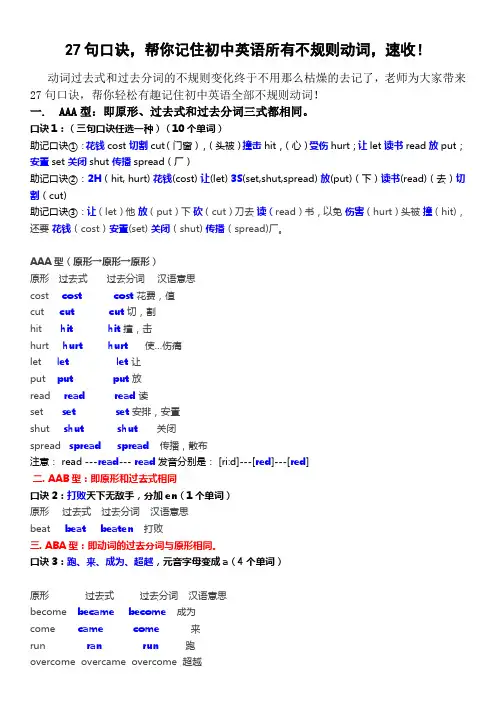
27句口诀,帮你记住初中英语所有不规则动词,速收!动词过去式和过去分词的不规则变化终于不用那么枯燥的去记了,老师为大家带来27句口诀,帮你轻松有趣记住初中英语全部不规则动词!一. AAA型:即原形、过去式和过去分词三式都相同。
口诀1:(三句口诀任选一种)(10个单词)助记口诀①:花钱cost 切割cut(门窗),(头被)撞击hit,(心)受伤hurt;让let 读书read 放put;安置set 关闭shut 传播spread(厂)助记口诀②:2H(hit, hurt) 花钱(cost) 让(let) 3S(set,shut,spread) 放(put)(下)读书(read)(去)切割(cut)助记口诀③:让(let)他放(put)下砍(cut)刀去读(read)书,以免伤害(hurt)头被撞(hit),还要花钱(cost)安置(set) 关闭(shut) 传播(spread)厂。
AAA型(原形→原形→原形)原形过去式过去分词汉语意思cost cost cost花费,值cut cut cut切,割hit hit hit撞,击hurt hurt hurt使…伤痛let let let让put put put放read read read读set set set安排,安置shut shut shut 关闭spread spread spread 传播,散布注意: read ---read--- read发音分别是: [ri:d]---[red]---[red]二. AAB型:即原形和过去式相同口诀2:打败天下无敌手,分加en(1个单词)原形过去式过去分词汉语意思beat beat beaten打败三. ABA型:即动词的过去分词与原形相同。
口诀3:跑、来、成为、超越,元音字母变成a(4个单词)原形过去式过去分词汉语意思become became become成为come came come来run ran run跑overcome overcame overcome 超越四. ABB型:即动词的过去式和过去分词相同。
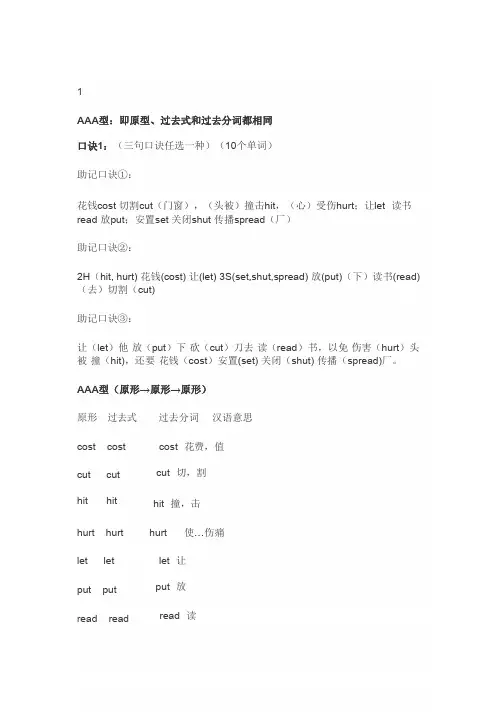
1AAA 型:即原型、过去式和过去分词都相同口诀1:(三句口诀任选一种)(10个单词)助记口诀①:花钱cost 切割cut (门窗),(头被)撞击hit ,(心)受伤hurt ;让let 读书 read 放put ;安置set 关闭shut 传播spread (厂)助记口诀②:2H (hit, hurt) 花钱(cost) 让(let) 3S(set,shut,spread) 放(put)(下)读书(read) (去)切割(cut)助记口诀③:让(let )他 放(put )下 砍(cut )刀去 读(read )书,以免 伤害(hurt )头 被 撞(hit),还要 花钱(cost )安置(set) 关闭(shut) 传播(spread)厂。
AAA 型(原形→原形→原形)原形 过去式过去分词 汉语意思 cost costcost 花费,值 cut 切,割 cuthit cut hit hit 撞,击hurt hurthurt 使…伤痛 let let let 让put 放read 读 put put read readset set set 安排,安置shut shut shut 关闭spread spread spread 传播,散布注意:read ---read--- read发音分别是: [ri:d]---[red]---[red] 2AAB型:即原型和过去式相同口诀2:打败天下无敌手,分加en(1个单词)原形过去式过去分词汉语意思beat3beat beaten 打败ABA型:即原型和过去分词相同口诀3:跑、来、成为、超越,元音字母变成a(4个单词)原形过去式过去分词汉语意思become became become 成为come run camerancomerun来跑overcome overcame overcome 超越4ABB型:即过去式和过去分词相同口诀4:教书被抓,有a则a, aught (2个单词)原形→aught →aught原形过去式过去分词汉语意思catch caught caught 捉,抓teach taught taught 教口诀5:想带来买(个)打架,无a则o, ought (4个单词)原形→ought →ought原形过去式过去分词汉语意思bring brought brought 带来buy bought boughtfought 买fight fought think thought 口诀6:打架思考thought加速射击喂牛遇见领导,“过分”后一个元音字母去掉了。
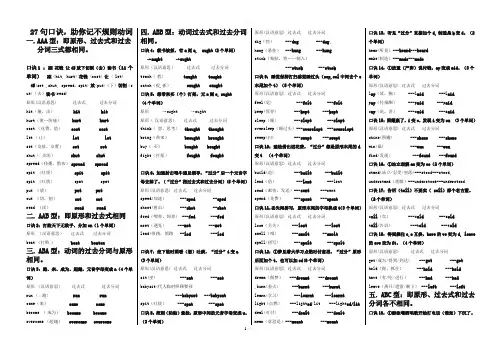
27句口诀,助你记不规则动词一.AAA型:即原形、过去式和过去分词三式都相同。
口诀1 :2H 花钱让4S放下切割(去)读书(11个单词)2H(hit, hurt)花钱(cost)让( let)4S(set ,shut, spread,spit)放(put)(下)切割(cut)(去)读书(read)原形(汉语意思)过去式过去分词hit(撞,击)hit hithurt(使…伤痛)hurt hurtcost(花费,值)cost costlet(让)let letset(安排,安置)set setshut(关闭)shut shutspread(传播,散布)spread spreadspit (吐痰) spit spitspit (吐痰) spat spatput(放)put putcut(切,割)cut cutread(读)read read二.AAB型:即原形和过去式相同口诀2:打败天下无敌手,分加en(1个单词)原形(汉语意思)过去式过去分词beat(打败)beat beaten三.ABA型:动词的过去分词与原形相同。
口诀3:跑、来、成为、超越,元音字母变成a(4个单词)原形(汉语意思)过去式过去分词run(跑)ran runcome(来)came comebecome (成为)became becomeovercome(超越)overcame overcome 四.ABB型:动词过去式和过去分词相同。
口诀4:教书被抓,有a则a, aught(2个单词)→aught →aught原形(汉语意思)过去式过去分词teach(教)taught taughtcatch(捉,抓)caught caught口诀5:想带来买(个)打架,无a则o,ought(4个单词)原形→ought →ought原形(汉语意思)过去式过去分词think(想,思考)thought thoughtbring(带来)brought broughtbuy(买)bought boughtfight(打架)fought fought口诀6:加速射击喂牛遇见领导,“过分”后一个元音字母去掉了。
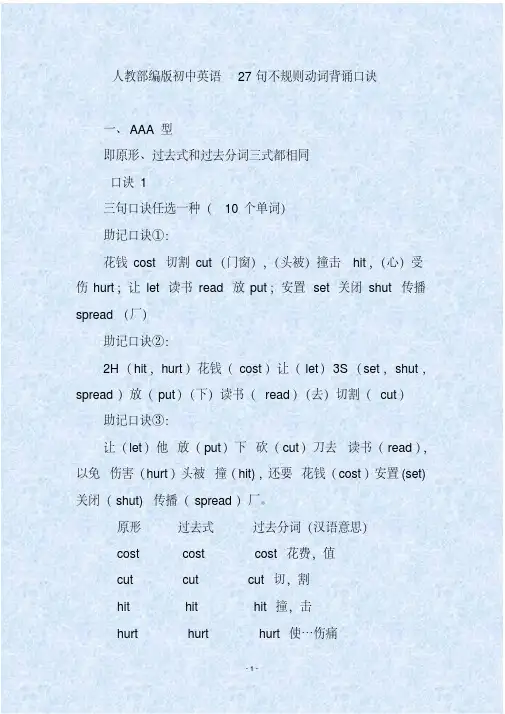
人教部编版初中英语27句不规则动词背诵口诀一、AAA型即原形、过去式和过去分词三式都相同口诀1三句口诀任选一种(10个单词)助记口诀①:花钱cost 切割cut(门窗),(头被)撞击hit,(心)受伤hurt;让let 读书read 放put;安置set 关闭shut 传播spread(厂)助记口诀②:2H(hit,hurt)花钱(cost)让(let)3S(set,shut,spread)放(put)(下)读书(read)(去)切割(cut)助记口诀③:让(let)他放(put)下砍(cut)刀去读书(read),以免伤害(hurt)头被撞(hit),还要花钱(cost)安置(set) 关闭(shut) 传播(spread)厂。
原形过去式过去分词(汉语意思)cost cost cost 花费,值cut cut cut 切,割hit hit hit 撞,击hurt hurt hurt 使…伤痛let let let 让put put put 放read read read 读set set set 安排,安置shut shut shut 关闭spread spread spread 传播,散布注意:read--read--read发音分别是:[ri:d]--[red]--[red]二. AAB型即原形和过去式相同口诀2打败天下无敌手,分加en(1个单词)原形过去式过去分词(汉语意思)beat beat beaten 打败三、ABA型即动词的过去分词与原形相同口诀3跑、来、成为、超越,元音字母变成a(4个单词)原形过去式过去分词(汉语意思)become became become 成为come came come 来run ran run 跑overcome overcame overcome 超越四、ABB型即动词的过去式和过去分词相同口诀4教书被抓,有a则a,aught (2个单词)原形→aught →aught原形过去式过去分词(汉语意思)catch caught caught 捉,抓teach taught taught 教口诀5想带来买(个)打架,无a则o,ought (4个单词)原形→ought →ought原形过去式过去分词(汉语意思)bring brought brought 带来buy bought bought 买fight fought fought 打架think thought thought 思考口诀6加速射击喂牛遇见领导,“过分”后一个元音字母去掉了。
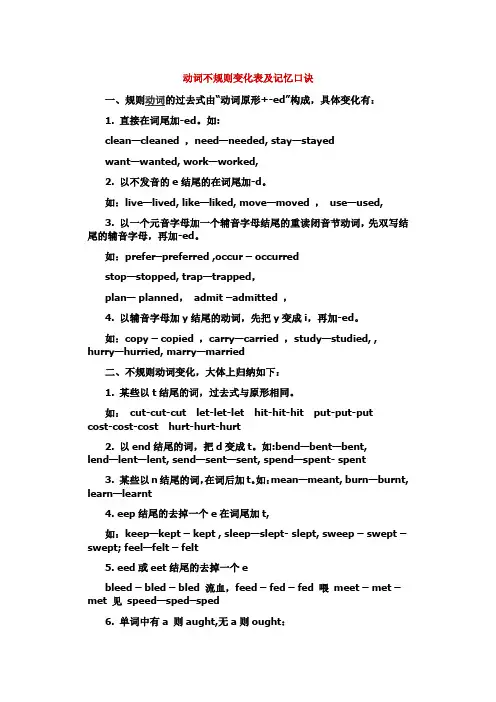
动词不规则变化表及记忆口诀1. 直接在词尾加-ed。
如:clean—cleaned ,need—needed, stay—stayedwant—wanted, work—worked,2. 以不发音的e结尾的在词尾加-d。
如:live—lived, like—liked, move—moved ,use—used,3. 以一个元音字母加一个辅音字母结尾的重读闭音节动词,先双写结尾的辅音字母,再加-ed。
如:prefer–preferred ,occur – occurredstop—stopped, trap—trapped,plan— planned,admit –admitted ,4. 以辅音字母加y结尾的动词,先把y变成i,再加-ed。
如:copy – copied ,carry—carried ,study—studied, , hurry—hurried, marry—married二、不规则动词变化,大体上归纳如下:1. 某些以t结尾的词,过去式与原形相同。
如:cut-cut-cut let-let-let hit-hit-hit put-put-putcost-cost-cost hurt-hurt-hurt2. 以end结尾的词,把d变成t。
如:bend—bent—bent, lend—lent—lent, send—sent—sent, spend—spent- spent3. 某些以n结尾的词,在词后加t。
如:mean—meant, burn—burnt, learn—learnt4. eep结尾的去掉一个e在词尾加t,如:keep—kept – kept , sleep—slept- slept, sweep – swept –swept; feel—felt – felt5. eed或eet结尾的去掉一个ebleed – bled – bled 流血,feed – fed – fed 喂meet – met –met 见speed—sped–sped6. 单词中有a 则aught,无a则ought:teach – taught – taught ; catch – caught – caught 口诀记忆:教书被抓think – thought ;bring – brought – brought , buy—bought ;fight – fought 口诀记忆:想带来买(个)打架A——B——C型(1)其元音字母变化为i→a→u1.drink drank drunk (喝)2. begin began begun (开始)3.swim swam swum (游泳)4. ring rang rung (铃响)(2)其元音字母变为i→o→变为en结尾口诀:升起驾驶骑车写字1.rise rose risen (升)2. drive drove driven (驾驶)3.ride(骑)—rode—ridden,4. write(写)—wrote—written(3)把中间的元音字母都变为o→变为en结尾口诀:偷盗醒来结冰打破选择说忘记break(打破)—broke—broken, choose(选择)—chose—chosen, freeze(结冰)—froze—frozen,speak(说)—spoke—spoken, forget(忘记)—forgot—forgotten,steal(偷盗)—stole—stolen, wake(醒来)—woke—woken(3)其词尾变化为ow(aw)→ew→own(awn) 口诀:长大后画画知道扔吹飞1.grow grew grown (成长)2. draw drew drawn (拖;拉)2.knowknewknown (知道)4. throw threw thrown (扔)blow(刮风)—blew—blown, throw(投)—threw—thrown,fly(飞)—flew—flown。
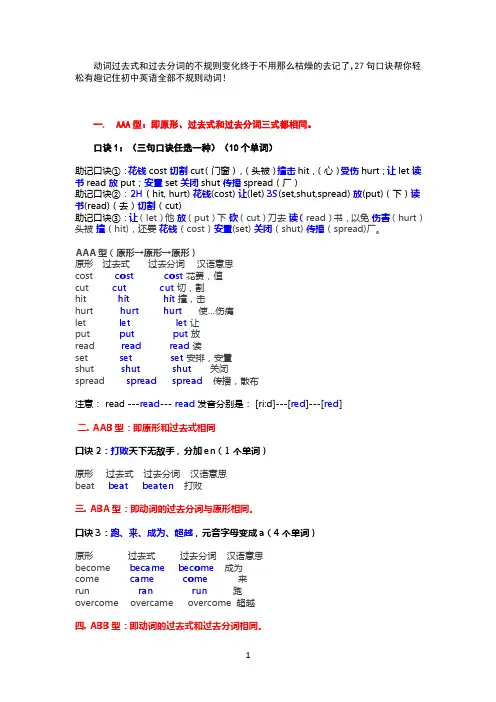
动词过去式和过去分词的不规则变化终于不用那么枯燥的去记了,27句口诀帮你轻松有趣记住初中英语全部不规则动词!一. AAA型:即原形、过去式和过去分词三式都相同。
口诀1:(三句口诀任选一种)(10个单词)助记口诀①:花钱cost 切割cut(门窗),(头被)撞击hit,(心)受伤hurt;让let 读书read 放put;安置set 关闭shut 传播spread(厂)助记口诀②:2H(hit, hurt) 花钱(cost) 让(let) 3S(set,shut,spread) 放(put)(下)读书(read)(去)切割(cut)助记口诀③:让(let)他放(put)下砍(cut)刀去读(read)书,以免伤害(hurt)头被撞(hit),还要花钱(cost)安置(set) 关闭(shut) 传播(spread)厂。
AAA型(原形→原形→原形)原形过去式过去分词汉语意思cost cost cost花费,值cut cut cut切,割hit hit hit撞,击hurt hurt hurt使…伤痛let let let让put put put放read read read读set set set安排,安置shut shut shut 关闭spread spread spread 传播,散布注意: read ---read--- read发音分别是: [ri:d]---[red]---[red]二. AAB型:即原形和过去式相同口诀2:打败天下无敌手,分加en(1个单词)原形过去式过去分词汉语意思beat beat beaten打败三. ABA型:即动词的过去分词与原形相同。
口诀3:跑、来、成为、超越,元音字母变成a(4个单词)原形过去式过去分词汉语意思become became become成为come came come来run ran run跑overcome overcame overcome 超越四. ABB型:即动词的过去式和过去分词相同。
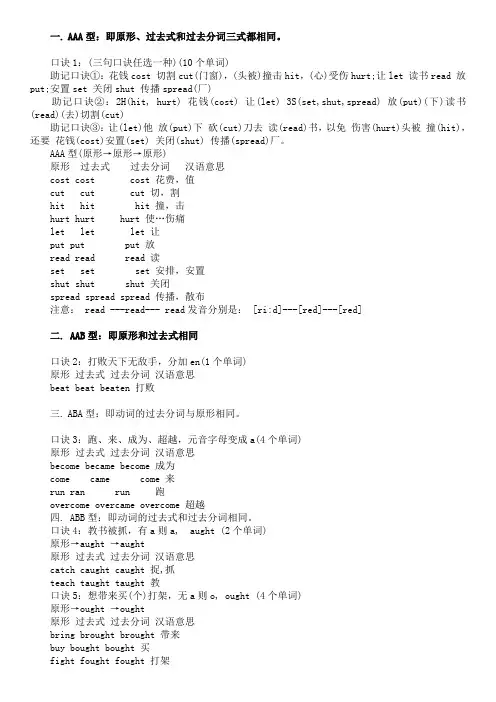
一.AAA型:即原形、过去式和过去分词三式都相同。
口诀1:(三句口诀任选一种)(10个单词)助记口诀①:花钱cost 切割cut(门窗),(头被)撞击hit,(心)受伤hurt;让let 读书read 放put;安置set 关闭shut 传播spread(厂)助记口诀②:2H(hit, hurt) 花钱(cost) 让(let) 3S(set,shut,spread) 放(put)(下)读书(read)(去)切割(cut)助记口诀③:让(let)他放(put)下砍(cut)刀去读(read)书,以免伤害(hurt)头被撞(hit),还要花钱(cost)安置(set) 关闭(shut) 传播(spread)厂。
AAA型(原形→原形→原形)原形过去式过去分词汉语意思cost cost cost 花费,值cut cut cut 切,割hit hit hit 撞,击hurt hurt hurt 使…伤痛let let let 让put put put 放read read read 读set set set 安排,安置shut shut shut 关闭spread spread spread 传播,散布注意: read ---read--- read发音分别是: [ri:d]---[red]---[red]二. AAB型:即原形和过去式相同口诀2:打败天下无敌手,分加en(1个单词)原形过去式过去分词汉语意思beat beat beaten 打败三.ABA型:即动词的过去分词与原形相同。
口诀3:跑、来、成为、超越,元音字母变成a(4个单词)原形过去式过去分词汉语意思become became become 成为come came come 来run ran run 跑overcome overcame overcome 超越四. ABB型:即动词的过去式和过去分词相同。
口诀4:教书被抓,有a则a, aught (2个单词)原形→aught →aught原形过去式过去分词汉语意思catch caught caught 捉,抓teach taught taught 教口诀5:想带来买(个)打架,无a则o, ought (4个单词)原形→ought →ought原形过去式过去分词汉语意思bring brought brought 带来buy bought bought 买fight fought fought 打架think thought thought 思考口诀6:加速射击喂牛遇见领导,“过分”后一个元音字母去掉了。
全巧记初中英语不规则动词过去式和过去分词(含110个不规则动词)一、AAA型即原形、过去式和过去分词三式都相同。
口诀1:(三句口诀任选一种)(10个单词)助记口诀①:花钱cost切割cut(门窗),(头被)撞击hit,(心)受伤hurt;让let读书read放put;安置set关闭shut传播spread(厂)助记口诀②:2H(hit, hurt)花钱(cost)让(let)3S(set,shut,spread)放(put)(下)读书(read)(去)切割(cut)助记口诀③:让(let)他放(put)下砍(cut)刀去读(read)书,以免伤害(hurt)头被撞(hit),还要花钱(cost)安置(set)关闭(shut)传播(spread)厂。
AAA型(原形→原形→原形)原形过去式过去分词汉语意思cost cost cost花费,值cut cut cut切,割hit hit hit撞,击hurt hurt hurt使…伤痛let let let让put put put放read read read读set set set安排,安置shut shut shut 关闭spread spread spread 传播,散布注意:read ---read--- read发音分别是[ri:d]---[red]---[red],二、AAB型口诀2:打败天下无敌手,分加en(1个单词)原形过去式过去分词汉语意思beat beat beaten打败三、ABA型:即动词的过去分词与原形是一样的。
口诀3:跑、来、成为、超越,元音字母变成a(4个单词)原形过去式过去分词汉语意思become became become成为come came come来run ran run跑overcome overcame overcome 超越四、ABB型:即动词的过去式和过去分词相同。
口诀4:教书被抓,有a则a,aught (2个单词)原形→aught →aught原形过去式过去分词汉语意思catch caught caught捉,抓teach taught taught教口诀5:想带来买(个)打架,无a则o, ought (4个单词)原形→ought →ought原形过去式过去分词汉语意思bring brought brought带来buy bought bought买fight fought fought打架think thought thought思考口诀6:加速射击喂牛遇见领导,“过分”后一个元音字母去掉了。
中考英语不规则动词口诀中考英语频道为大家提供中考英语不规则动词口诀,一起来记忆一下吧!更多中考英语复习资料我们网站的更新!中考英语不规则动词口诀动词过去式和过去分词的不规则变化终于不用那么枯燥的去记了,27句口诀,帮你轻松有趣记住初中英语全部不规则动词!一. AAA型:即原形、过去式和过去分词三式都相同。
口诀1:(三句口诀任选一种)(10个单词)助记口诀①:花钱cost 切割cut(门窗),(头被)撞击hit,(心)受伤hurt;让let 读书read 放put;安置set 关闭shut 传播spread(厂) 助记口诀②:2H(hit, hurt) 花钱(cost) 让(let)3S(set,shut,spread) 放(put)(下)读书(read)(去)切割(cut) 助记口诀③:让(let)他放(put)下砍(cut)刀去读(read)书,以免伤害(hurt)头被撞(hit),还要花钱(cost)安置(set) 关闭(shut) 传播(spread)厂。
AAA型(原形→原形→原形)原形过去式过去分词汉语意思cost costcost花费,值cut cutcut切,割hit hithit撞,击hurt hurthurt使…伤痛let letlet让put putput放read readread读set setset安排,安置shut shut shut 关闭spread spread spread 传播,散布注意: read ---read--- read发音分别是: [ri:d]---[red]---[red]二. AAB型:即原形和过去式相同口诀2:打败天下无敌手,分加en(1个单词)原形过去式过去分词汉语意思beat beatbeaten打败三. ABA型:即动词的过去分词与原形相同。
口诀3:跑、来、成为、超越,元音字母变成a(4个单词)原形过去式过去分词汉语意思become becamebecome成为come camecome来run ranrun跑overcomeovercameovercome超越四. ABB型:即动词的过去式和过去分词相同。
一. AAA型:即原形、过去式和过去分词三式都相同。
口诀1:(三句口诀任选一种)(10个单词)助记口诀①:花钱cost 切割cut(门窗),(头被)撞击hit,(心)受伤hurt;让let 读书read 放put;安置set 关闭shut 传播spread(厂)助记口诀②:2H(hit, hurt) 花钱(cost) 让(let) 3S(set,shut,spread) 放(put)(下)读书(read)(去)切割(cut)助记口诀③:让(let)他放(put)下砍(cut)刀去读(read)书,以免伤害(hurt)头被撞(hit),还要花钱(cost)安置(set) 关闭(shut) 传播(spread)厂。
AAA型(原形→原形→原形)cost cost cost 花费,值cut cut cut 切,割hit hit hit 撞,击hurt hurt hurt 使…伤痛let let let 让put put put 放read read read 读set set set 安排,安置shut shut shut 关闭spread spread spread 传播,散布注意: read ---read--- read发音分别是: [ri:d]---[red]---[red]二. AAB型:即原形和过去式相同口诀2:打败天下无敌手,分加en(1个单词)beat beat beaten 打败三. ABA型:即动词的过去分词与原形相同。
口诀3:跑、来、成为、超越,元音字母变成a(4个单词)become became become 成为come came come 来run ran run 跑overcome overcame overcome 超越四. ABB型:即动词的过去式和过去分词相同。
口诀4:教书被抓,有a则a, aught (2个单词)原形→aught →aughtcatch caught caught 捉,抓teach taught taught 教口诀5:想带来买(个)打架,无a则o, ought (4个单词)原形→ought →oughtbring brought brought 带来buy bought bought 买fight fought fought 打架think thought thought 思考口诀6:加速射击喂牛遇见领导,“过分”后一个元音字母去掉了。
27句口诀-突破中考初中英语所有不规则动词动词过去式和过去分词的不规则变化终于不用那么枯燥的去记了,为大家带来27句口诀,帮你轻松有趣记住初中英语全部不规则动词。
一. AAA型:即原形、过去式和过去分词三式都相同。
口诀1:(三句口诀任选一种)(10个单词)助记口诀①:花钱cost 切割cut(门窗),(头被)撞击hit,(心)受伤hurt;让let 读书read 放put;安置set 关闭shut 传播spread(厂)助记口诀②:2H(hit, hurt) 花钱(cost) 让(let) 3S(set,shut,spread) 放(put)(下)读书(read)(去)切割(cut)助记口诀③:让(let)他放(put)下砍(cut)刀去读(read)书,以免伤害(hurt)头被撞(hit),还要花钱(cost)安置(set) 关闭(shut) 传播(spread)厂。
AAA型(原形→原形→原形)原形过去式过去分词汉语意思cost cost cost 花费,值cut cut cut 切,割hit hit hit 撞,击hurt hurt hurt 使…伤痛let let let 让put put put 放read read read 读set set set 安排,安置shut shut shut 关闭spread spread spread 传播,散布注意:read ---read--- read发音分别是: [ri:d]---[red]---[red]二. AAB型:即原形和过去式相同口诀2:打败天下无敌手,分加en(1个单词)原形过去式过去分词汉语意思beat beat beaten 打败三. ABA型:即动词的过去分词与原形相同。
口诀3:跑、来、成为、超越,元音字母变成a(4个单词)原形过去式过去分词汉语意思become became become 成为come came come 来run ran run跑overcome overcame overcome 超越四. ABB型:即动词的过去式和过去分词相同。
27句话巧记不规则动词过去式过去分词一、AAA型即原形、过去式和过去分词三式都相同口诀1三句口诀任选一种(10个单词)助记口诀①:花钱cost 切割cut(门窗),(头被)撞击hit,(心)受伤hurt;让let 读书read 放put;安置set 关闭shut 传播spread(厂)助记口诀②:2H(hit,hurt)花钱(cost)让(let)3S(set,shut,spread)放(put)(下)读书(read)(去)切割(cut)助记口诀③:让(let)他放(put)下砍(cut)刀去读书(read),以免伤害(hurt)头被撞(hit),还要花钱(cost)安置(set) 关闭(shut) 传播(spread)厂。
原形过去式过去分词(汉语意思)cost cost cost 花费,值cut cut cut 切,割hit hit hit 撞,击hurt hurt hurt 使…伤痛let let let 让put put put 放read read read 读set set set 安排,安置shut shut shut 关闭spread spread spread 传播,散布注意: read--read--read发音分别是: [ri:d]--[red]--[red]二. AAB型即原形和过去式相同口诀2打败天下无敌手,分加en(1个单词)原形过去式过去分词(汉语意思)beat beat beaten 打败三. ABA型即动词的过去分词与原形相同口诀3跑、来、成为、超越,元音字母变成a(4个单词)原形过去式过去分词(汉语意思)become became become 成为come came come 来run ran run 跑overcome overcame overcome 超越四. ABB型即动词的过去式和过去分词相同口诀4教书被抓,有a则a,aught (2个单词)原形→aught →aught原形过去式过去分词(汉语意思)catch caught caught 捉,抓teach taught taught 教口诀5想带来买(个)打架,无a则o, ought (4个单词)原形→ought →ought原形过去式过去分词(汉语意思)bring brought brought 带来buy bought bought 买fight fought fought 打架think thought thought 思考口诀6加速射击喂牛遇见领导,“过分”后一个元音字母去掉了。
27句口诀帮你记住初中英语所有不规则动词动词过去式和过去分词的不规则变化终于不用那么枯燥的去记了,小编为大家带来27句口诀,帮你轻松有趣记住初中英语全部不规则动词!一、AAA型:原形、过去式和过去分词都相同口诀1:(三句口诀任选一种)(10个单词)助记口诀①:花钱cost 切割cut(门窗),(头被)撞击hit,(心)受伤hurt;让let 读书read 放put;安置set 关闭shut 传播spread(厂)助记口诀②:2H(hit,hurt)花钱(cost)让(let)3S (set,shut,spread)放(put)(下)读书(read)(去)切割(cut)助记口诀③:让(let)他放(put)下砍(cut)刀去读(read)书,以免伤害(hurt)头被撞(hit),还要花钱(cost)安置(set)关闭(shut)传播(spread)厂。
AAA型(原形→原形→原形)原形过去式过去分词汉语意思cost cost cost 花费,值cut cut cut 切,割hit hit hit 撞,击hurt hurt hurt 使…伤痛let let let 让put put put 放read read read 读set set set 安排,安置shut shut shut 关闭spread spread spread 传播,散布注意:read ---read--- read发音分别是:[ri:d]---[red]---[red]二、AAB型:即原形和过去式相同口诀2:打败天下无敌手,分加en(1个单词)原形过去式过去分词汉语意思beat beat beaten 打败三、ABA型:即动词的过去分词与原形相同口诀3:跑、来、成为、超越,元音字母变成a(4个单词)原形过去式过去分词汉语意思become became become 成为come came come 来run ran run 跑overcome overcame overcome 超越四、ABB型:即动词的过去式和过去分词相同口诀4:教书被抓,有a则a,aught (2个单词)原形→aught →aught原形过去式过去分词汉语意思catch caught caught 捉,抓teach taught taught 教口诀5:想带来买(个)打架,无a则o,ought (4个单词)原形→ought →ought原形过去式过去分词汉语意思bring brought brought 带来buy bought bought 买fight fought fought 打架think thought thought 思考口诀6:加速射击喂牛遇见领导,“过分”后一个元音字母去掉了。
(“过分”指过去式和过去分词)(5个单词)speed(加速)---sped--sped(speed(加速)---speeded--speeded)shoot(射击)---shot--shotfeed(喂养,饲养---fed---fedmeet(遇见)---met---metlead(带路,领路--led---led口诀7:坐下临时照看(想)吐痰,“过分”i变a。
(3个单词)sit(坐)---sat---sat,babysit(代人临时照顾婴孩)---babysat---babysatspit(吐痰)---spat---spat口诀8:挖刺(粘贴)悬挂,原形中间的元音字母变成u。
(3个单词)dig(挖)---dug---dug ,hang(悬挂)---hung---hung,stick(粘贴,将……刺入)---stuck---stuck口诀9:①(清洁工)睡觉(时还)保持打扫(的)感觉(却)睡过头(eep,eel中间去个e末尾加个t)(5个单词)②我觉(feel)得,卫生靠平时保持(keep),睡觉(sleep)时就不要想着扫(sweep)地了,可以睡过头(oversleep)。
feel(觉)---felt---feltkeep(保存)---kept---keptsleep(睡)---slept---sleptoversleep(睡过头)---overslept---oversleptsweep(扫)---swept---swept口诀10:①建造借出送花费,“过分”都是原形末尾的d 变t。
(4个单词)②我花钱(spend)建造(build)的房子,可以借(lend)给你,不能送(send)给你。
build(造)---built---builtlend(借)---lent---lentsend(邮寄,发送)---sent---sentspend(花费)---spent---spent口诀11:丢失闻拼写原形末尾的字母换成t。
(3个单词)lose(丢失)---lost---lostsmell(嗅)---smelt--smeltspell(拼写)---spelt---spelt口诀12:①梦见着火学习对付意思,“过分”原形后面加个t,梦见着火学习点燃也可以加ed。
(6个单词)②“‘燃烧’(burn)意思是(mean)什么?”我没有学会(learn),我做梦(dream)了,该怎么对付(deal)burn(着火)---burnt---burnt,dream(做梦)---dreamt---dreamt,learn(学习)---learnt---learnt,deal(对付)---dealt---dealtmean(意思是)---meant---meantlight(点燃)---lighted/---lighted,light(点燃)---lit/---lit,口诀13:听见“过分”直接加个d,制造是k变d。
(2个单词)hear(听见)---heard---heardmake(制造)---made---made口诀14①放置(产卵)说付钱,ay变成aid。
(3个单词)②一只下蛋(lay)的鹅说(say):“赶快付钱(pay)”。
lay(放,搁)---laid---laid,pay(付报酬)---paid---paid,say(说,讲)---said---said口诀15:照耀赢了,i变o,发现i变为ou。
(3个单词)shine(照耀)---shone---shonewin(赢)---won---won,find(发现)---found---found口诀16:①站立理解an变为oo。
(2个单词)②站(stand)着就听明白(understand)了。
stand(站立/忍受/坐落)---stood---stood,understand(理解)---understood---understood口诀17:①告诉卖(老头)ell变old。
(2个单词)②告诉(tell)他不要卖(sell)那个老古董。
sell(卖)---sold---soldtell(告诉)---told---told口诀18:得到握住e,o互换,have的ve变为d,leave 的ave变为ft。
(4个单词)get(成为/得到/到达)---got---gothold(握,抓住)---held---heldhave(有/吃/进行)---had---hadleave(离开/遗留/剩下)---left---left五、ABC型:即原形、过去式和过去分词各不相同口诀19:①游泳喝酒唱歌开始打电话(谁知)下沉了。
i---a---u(原形中含有字母i,在过去式中变为a,在过去分词中变为u。
)(6个单词)②铃响(ring)后,开始(begin)唱歌(sing),游泳(swim)时,不要喝(drink)太多的水,否则会下沉(sink)的。
begin(开始,着手)---began---begundrink(喝,饮)---drank---drunkring(响铃/打电话)---rang---rungsing(唱歌)---sang---sungsink(下沉)---sank---sunkswim(游泳)---swam---swum口诀20:①长大后画画知道扔吹飞,过变ew,分加n(以字母ow或aw结尾的动词,在过去式中变成ew,过去分词则在原形后加-n。
)(6个单词)②长(grow)大后,才知道(know),不要乱扔(throw)乱吹(blow)乱画(draw)。
blow(刮风)---blew---blowngrow(成长/种植)---grew---grownknow(知道)---knew---knownthrow(投)---threw---throwndraw(绘画)---drew---drawnfly(飞)---flew---flown注意:飞口诀21:生育穿戴,ear过变ore,分变orn(原形-ear,过去式-ore,过去分词-orn。
)(2个单词)bear(生育)---bore---bornwear(穿)---wore---worn口诀22:偷盗醒来结冰打破选择说忘记,过去元音变成o,偷盗打破说未成还要e尾随,分词“过”后加n。
(7个单词)break(打破)---broke---broken,choose(选择)---chose---chosen,freeze(结冰)---froze---frozen,speak(说)---spoke---spoken,forget(忘记)---forgot---forgotten,steal(偷盗)---stole---stolen,wake(醒来)---woke---woken,注意:忘记分词要双写t口诀23:升起驾驶骑车写字,过i变o(眼睁大),分加en,注意骑车写字双写辅音(d和t)。
(4个单词)rise(升起/出现)---rose----risendrive(驾驶/驱赶)---drove---drivenride(骑)---rode---riddenwrite(写)---wrote---written口诀24:规则的撒谎,不规则的躺,躺下就下蛋,下蛋不规则。
(3个单词)lie(躺/平放/位于)---lay---lain,lie (撒谎、说谎)---lied ---liedlay (放置,产卵,下蛋)---laid ---laid口诀25:是给吃看见落下,隐藏弄错摇动拿,分词结尾是en。
(9个单词)be(是)---was/were---beengive(给)---gave---giveneat(吃)---ate---eatensee(看见)---saw---seenfall(落下)---fell---fallenhide(隐藏)---hid---hiddenmistake(弄错)---mistook---mistakenshake(摇动)---shook---shakentake(拿)---took---taken口诀26:其他变化形式(3个)do,did,done,go,went,gone,我们常常见;show,showed,shown展示看do(做/干)---did---donego(去/到达)---went---goneshow(出示)---showed---shown六、没有过去分词的动词(情态动词)口诀27:can(能/可能)---could,may(可以/可能)---mightshall(将/会)---should,will(将/愿意)---would。